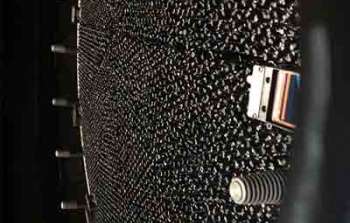sci19033 — Announcement
NOAO at the January AAS Meeting
August 18, 2019
The following special sessions are planned for the January 2020 meeting of the American Astronomical Society.
DESI in bloom. All ten “petals,” each of which holds 500 fiber-positioning robots, were recently installed in the DESI instrument at the Mayall telescope on Kitt Peak.
DESI Imaging and First Light Spectroscopy
Arjun Dey, NOAO
The Dark Energy Spectroscopic Instrument (DESI) consists of imaging surveys over 16,000 square degrees (see the related data release article in this issue) followed by 3600-9800 angstrom spectroscopy of 35 million galaxies and quasars that aims to probe the role of dark energy in the expansion history of the universe. This special session will provide an overview of the DESI instrument and feature talks on the DESI Legacy Imaging Survey and DESI targeting; maximizing the legacy of WISE infrared imaging for DESI and beyond; first light tests of DESI targets; commissioning the 5000 DESI fiber robots; the DESI instrument and performance; and initial data from the DESI spectrographs.
Splinter Session on the Zwicky Transient Facility Community Survey
Steve Ridgway, NOAO (for ZTF and its Community Science Advisory Committee)
The Zwicky Transient Facility is engaged in a 3-year survey of the transient sky. As part of the MSIP funding agreement with NSF, the survey includes both private and public observing programs. The public survey, utilizing 40% of available on-sky time, provides immediate broadcasts of transient alerts and timely publication of cumulative catalogs. In a planned splinter session at the January AAS meeting, the ZTF project, in collaboration with the ZTF Community Science Advisory Committee, will present the status of the community survey and provide information about Data Release 2 (expected in December 2019). We will discuss a new survey element, begun on 18 July 2019, that shadows the on-going TESS mission fields with daily visits. Participants are invited to bring ideas and join the discussion on the disposition of ZTF community survey time during the next 12 months.
Imaging Stars: a Century of Advances in High Angular Resolution Astronomy
Gail Schaefer (CHARA) & Steve Ridgway (NOAO)
CHARA maintains a small interferometry museum at its site on Mt Wilson, where you can see the original optical support beam used by Michelson and Pease to adapt the 100” telescope to observe with 20 foot aperture separation. (Image credit: Gail Schaefer)
This session will commemorate the first interferometric measurement in 1920 of a stellar diameter by Albert Michelson and Francis Pease. Invited speakers will include Doug Gies, Andrea Dupree, John Monnier, Gioia Rau and Daniel Huber. There will be an associated poster session. A website for the event (http://www.chara.gsu.edu/workshops/aas-special-session-2020) will be updated as schedule and other details become available. We remind readers that access to the CHARA Array, supported by Georgia State University and partially funded by the NSF MSIP program, is available through the NOAO TAC.
Threats to Astronomy from Lighting and Satellites
Constance Walker, NOAO
Image of the NGC 5353/4 galaxy group on 25 May 2019. The diagonal lines are trails of reflected light left by some of the 60 recently launched Starlink satellites as they passed through the field of view. Note that the satellite density declined in the days after launch, compared to that seen here. The satellites also diminished in brightness as they reached their final orbital altitude. (Image credit: Victoria Girgis/Lowell Observatory)
The commercial world has plans to deploy potentially thousands of low-Earth orbit satellites, outnumbering all previously launched satellites. As members of the astronomical community, we need to understand the impact of these plans on our field, as well as possible solutions, and how to work collaboratively with designers, deployers, and policy-makers at this new, largely unregulated frontier of space. Join us at this special session, held by the AAS Committee on Light Pollution, Radio Interference and Space Debris, where you can discuss these and related issues with a panel of experts.
Planets, Exoplanets, and Planet Formation with Gemini Large and Long Programs
Letizia Stanghellini (NOAO), Ken Hinkle (NOAO), and Alison Peck (Gemini)
Science from Gemini Large and Long Programs (LLP) will be showcased in a focused meeting organized by the US NGO, in collaboration with Gemini. This Splinter meeting will focus on science from mature LLPs in the field of planets and their formation. Speakers will be selected from PIs and co-Is of these programs, and other experts in the field. Talks will present the science results along with data analysis strategies.
About the Announcement
| Id: |
ID
sci19033
|



